Making Gâteau St. Honoré
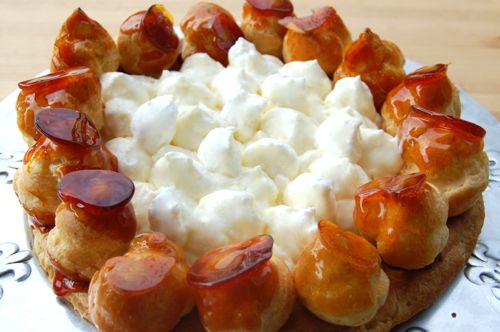
Every so often a pastry comes along that makes even the most jaded sweet-eater throw down his fork, stomp his foot and shout out loud:
my GOD that’s good. Gâteau St. Honoré is that pastry. Yes, you may think you know what it tastes like: cream puff dough, pastry cream, meringue and caramel. But I’m telling you friends, until you actually prepare and serve one of these you won’t understand the impact that all those components can have when they’re delivered together. The uninitiated are always, always stunned.
The nice thing is that while this pastry is rather involved it isn’t strictly speaking “hard” to make. You can even spread the preparation out over days or weeks if you like. Allow me to explain…as I preheat my oven to 450.
Here I have about a ten-ounce ball of puff pastry scraps that I’ve been keeping in my freezer (they’re thawed of course). You can use an equal amount of non-scrap homemade puff pastry or store-bought puff pastry.
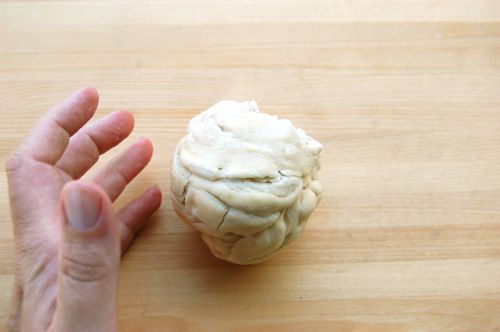
I roll it out into a sheet about 12″ on all sides…
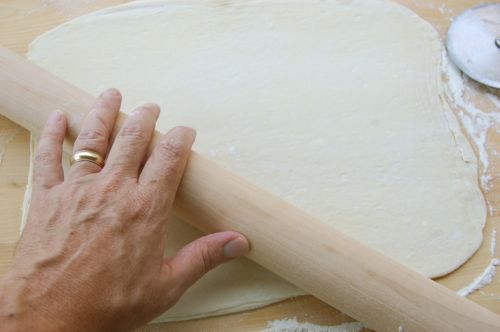
…then I place a 9″ to 10″ form — like this tarnished pot lid — over the sheet. I trim around it with a pizza cutter.

I then dock the circle with a fork to keep it from rising very much. I stick that in the fridge on a parchment-lined sheet pan while I prepare the choux.
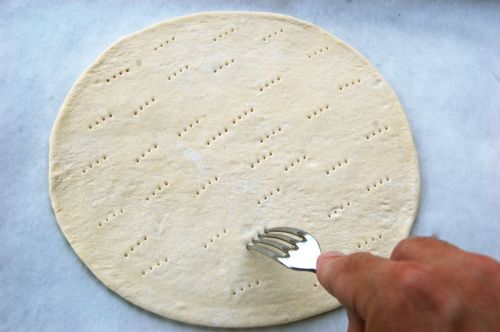
When the choux is ready, I load it into a piping bag with just the collar (no tip) and pipe a thick line around the edge. I press the bag firmly and remember to hold the tip of the bag about an inch from the piping surface. I don’t extrude the batter, I let it fall from the tip.
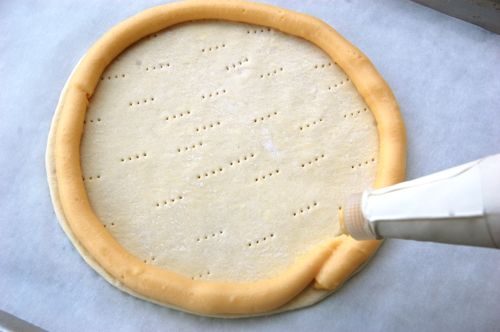
Now I go over to a second parchment-lined sheet pan and pipe some cream puffs, about 18 of them. With a lightly moistened fingertip, I pat down any pointy bits.

Now I return to the pastry circle, and with any remaining batter I pipe a curlicue in the middle of the circle. This is mostly just to use up batter and fill space. If you don’t pipe this perfectly it’s no big deal…at all.
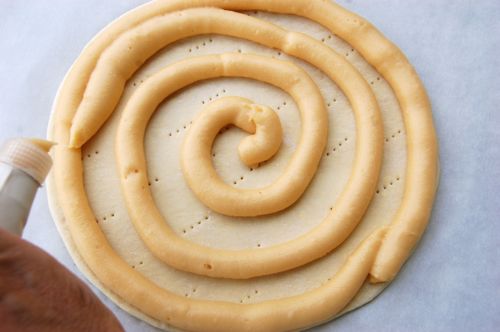
I insert both pans on upper racks in my oven, placing the handle-end of a wooden spoon in the door. What does that do? It keeps the over door open about 1/4″, and that allows steam to escape. Don’t skip that part. It’s important.
I bake for 10 minutes at 450, then turn the heat down and bake another five minutes at 400. By then the puffs should be, er, puffy and well browned. I take them out of the oven.

After a further ten minutes the base should be nicely browned. Don’t be afraid to get it a little on the dark side. You get a better look and more complex flavor that way.
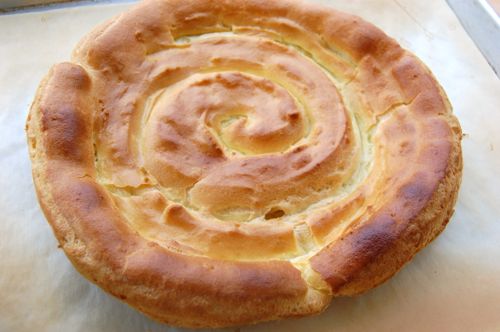
If you’ve had enough at this point you can stop for up to several weeks. How’s that? Because choux freezes very, very well. Put the puffs in freezer bags and wrap the base in thick plastic wrap. It’ll keep nicely. When you’re ready to assemble the pastry, affix a narrow tip to the pastry bag and fill it with pastry cream. Here I’m using a big ol’ Bismarck tip. Fill the puff, but not to bursting. You don’t want these things too heavy.

Once that’s done, I prepare the caramel by swirling a cup of sugar and a 1/4 cup of water in a shallow pan over high heat until it’s just past a light amber color. I turn off the heat and take the pan off the burner. The caramel will continue to cook for the next 30 seconds or so. While the caramel is still liquid, I dip the tops of the cream puffs — careful now, they don’t call this stuff “bakery napalm” for nothing.
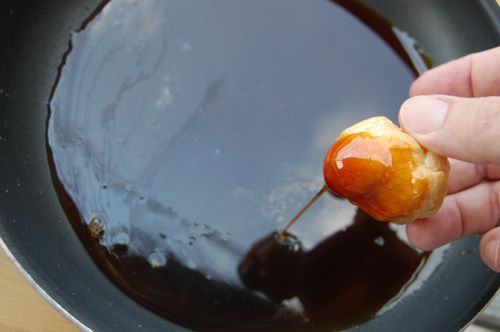
Now I rest the puffs — top side down — on yet another parchment-lined baking sheet, leaning them against the edges so they don’t roll over. If you don’t like those little flat tops, you can set the puffs right-side-up instead. I like those odd little shapes, myself. They not only look vaguely sculptural, they provide your guests with a nice, greedy bite of caramel candy. Oh that’s good.

But where was I? Right. When they’re all done, I return to the first puff and dip the bottom (note that if the caramel is hardening at this stage, you can just return the pan to the stove top…high heat for 20 or 30 seconds loosened it back up).

Then one by one, I stick the cream puffs on the edge of the base…
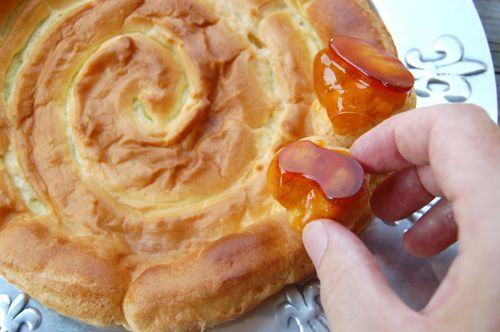
…until I have a complete border. I put the whole thing into the refrigerator while I made the chiboust. I could keep the base in the fridge all day at this point if I need to, and make the chiboust later. That’s up to you.

When the chiboust is ready I spoon some into the base to fill up some of the volume…
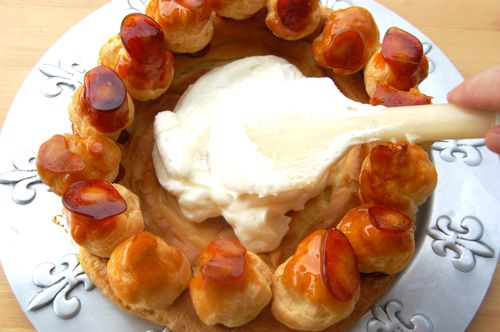
…then with a pastry bag — with no tip or collar — I gently pipe large blobs of filling into the center in no particular pattern. (Forgive me for not showing this, but it was 95 with 90% humidity yesterday, and the chiboust was melting fast in the oppressive environment…plus my girls were trying to hit me with water balloons — all in all less than ideal conditions for pastry making).
If you don’t want to go to the trouble of making chiboust, pastry cream lightened with whipped cream (about 2 parts whipped cream to 1 part pastry cream) will also work splendidly. Chantilly cream (whipped cream with a little sugar and vanilla added is also very nice).

And I’m done. This pastry can be refrigerated for 6-8 hours before serving, but should be eaten the same day. Note that you can simply use sweetened whipped ream (Chantilly cream) if you wish. Either way it’s a knockout.
That is kitchen artwork!
Thank you, Kathy! It was fun to do!
That one’s a real stunner!
One question: why doesn’t the hot caramel stick to the parchment paper? I always thought parchment needed heat to be come nonstick and that’s why, for example, raw dough sticks to parchment.
Hey Evan!
And thanks! A very gummy caramel often sticks to parchment. Some caramels will as well if they’re full of butter or cream. Unadulterated caramel is more like candy, so it firms up to a very hard texture with a smooth surface. That said, I use parchment that’s silicone-coated, which helps!
– Joe
(PS – Gonna get back with you on your longer email…things have been just a little too busy the last few days.)
OMG – there’s something inappropriately satisfying about this.
What could possibly be inappropriate about this much fat and sugar?
nobody can beat joepastry in pictures and illustrations; your daughter must be very lucky to savour these goodies.:-).
Inappropriate? NEVER! This delicious masterpiece is a thing of beauty! Everything in moderation and ENJOY!!!!!
SB
SugarBeams
Hi Joe P. ,I was wondering what methods are used when making Gateau St. Honre? Biscuit, Muffin, 2-Stage, Foam. I need to know all the methods used. My Chef wants us to know, but he wont tell us.
Ty Joe!
Hey Allan! That’s a great question. Let’s break it down. Gateau St. Honore contains:
Puff pastry
Choux
Pastry cream
Caramel
Chiboust or meringue
Now, a lot of people use short crust for the base instead of puff pastry. If he favors a short crust then that’s the biscuit method. If he favors puff pastry then that’s the roll-in method.
Choux is what some people call the “boiled paste” or the “roux” method.
Pastry cream is custard, I don’t think there’s a specific “mixing method” there…is there? The custard method? I’m not are of one.
Caramel, we can skip that.
Meringue or chiboust would of course be the egg foam method.
Those are all the mixing methods I can think of for that preparation. That chef of yours is one clever customer! I like he way his evil mind works. Good luck on the test! Let me know how you do! 😉
– Joe
Terrific!!
Thank you. Many happy minutes browsing…and not a calorie on my hips…(yet!)
Am into Gluten free baking…and need techie advice, please.
Need a suitable filling for Vanilla Slices.
Could be Custard…or cream….or what would you recommend..provided its gluten free…
Many thanks
Hi Janet!
The easiest would be whipped cream so long as you eat them fairly soon. Pastry cream is another good possibility. It’s a stirred custard, thickened with corn starch. If you wanted something more frosting-like you could do Heritage frosting, using corn starch instead of wheat flour. Those are my best suggestions. Good luck!
– Joe
Wish I’d run across your wonderful instruction & photos before attempting this the 1st time using a Graham Kerr recipe sans any photos at all! Have now done 3 of them, but (duh!) never thought about tamping down the little points or (duh again!) the wooden spoon in the door trick–but the decadent results were still enjoyed by all!
But one of his tips I will pass along would be to add a teaspoon of light corn syrup to the caramel–never a risk of forming those nasty crystals & easier than brushing pan sides with water. Forgot that little tidbit when doing Croquembouche (once you have the St. Honore knack, pretty darn similar!) at Christmas & had a lumpy do-over.
Bravo for you & your site!
Thanks so much, Cindy! The nice thing about practicing those gateaux is that you get to eat the results. I don’t think I’ll ever get sick of attempting gateau St. Honore. Thanks so much for the note!
– Joe
Hi Joe, Nearly Merry Christmas from Australia! As an old passionate foodie who has newly discovered surfing the net for recipe ideas I was so pleased to find your site! I had a nostalgic moment this morning thinking about the lovely floury man who taught me pastry work at school and had a craving to make Gateau St Honore. Searching for a reason, it turns out to be a friends 50th tomorrow (knew I’d find an excuse – ha!) Thanks to you and some of your tips (the letting the steam out of the oven was a pearler!) the cake looks great and I know will be loved by Pete. Thanks so much – I will be checking in regularly from now on. Best wishes Kate
Well done, Kate! And thanks so much for checking in. Please do come back when you can…I’ll be here!
– Joe
WOW! I have got to make this one
You won’t regret it, Nathalie! Let me know how it goes!
– Joe
you’ve gained another follower!
And very glad to have you too, Chris! Thanks and welcome aboard!
Cheers,
– Joe
Hi Joe,
I am attempting to make this tomorrow for my husband who is french. It is his birthday and he had this cake almost every year for his celebration in France. (no pressure, lol) Question, if I use pastry cream lightened with whipped cream (about 2 parts whipped cream to 1 part pastry cream) instead of making chiboust, should I sweeten the whipped cream? Then I top the cake with Chantilly cream? Thanks for your help. great site.
Regards,
Tammy
Hey Tammy!
Good for you for taking this on! I think you’ll have fun with it so long as you don’t imagine all the pastry chefs of France looking over your shoulder. 😉
For the filling just use the mixture you mentioned: a combo of pastry cream and Chantilly (sweetened whipped) cream. No need to make two fillings — this cake is involved enough as it is! As mentioned in the tutorial, shoot for a roughly 2-1 mixture of the two creams. Be sure to whip your cream until it’s good and firm:
http://joepastry.com/category/techniques/whipping-cream/
If the filling seems too soft and fluffy as you’re combining them, just fold in more pastry cream to firm it up. There are no hard and fast rules here. The main thing — as mentioned — is to have a good time! Joyeux anniversaire to your husband!
– Joe